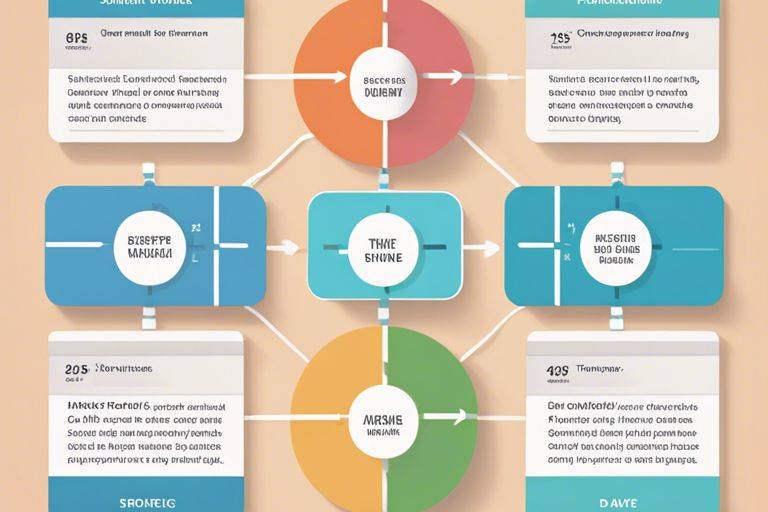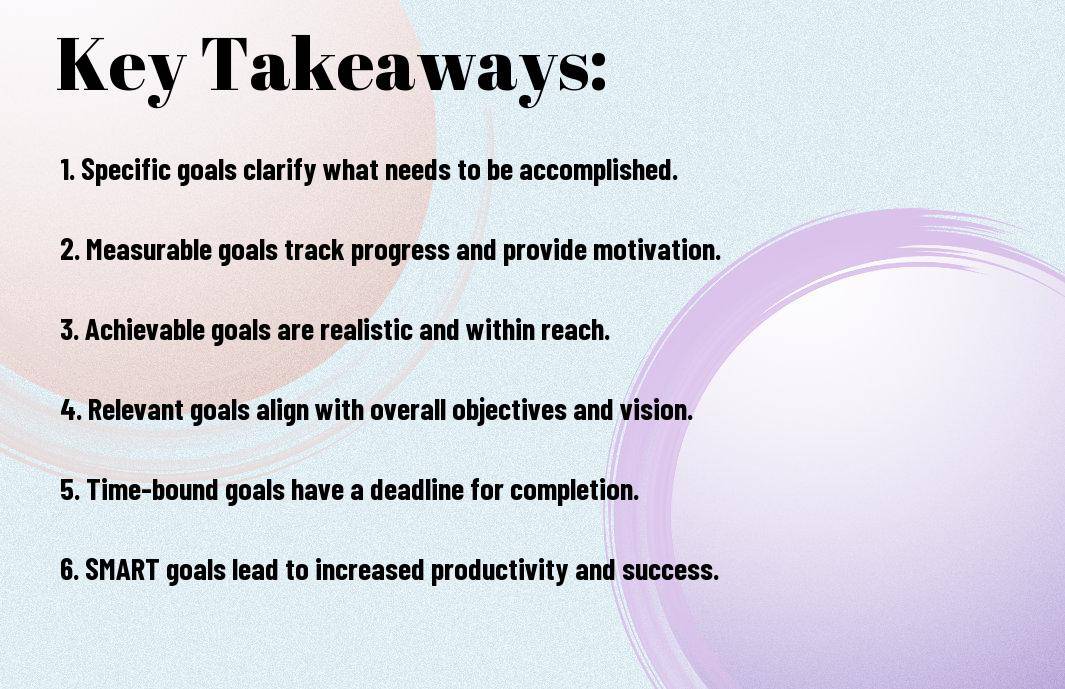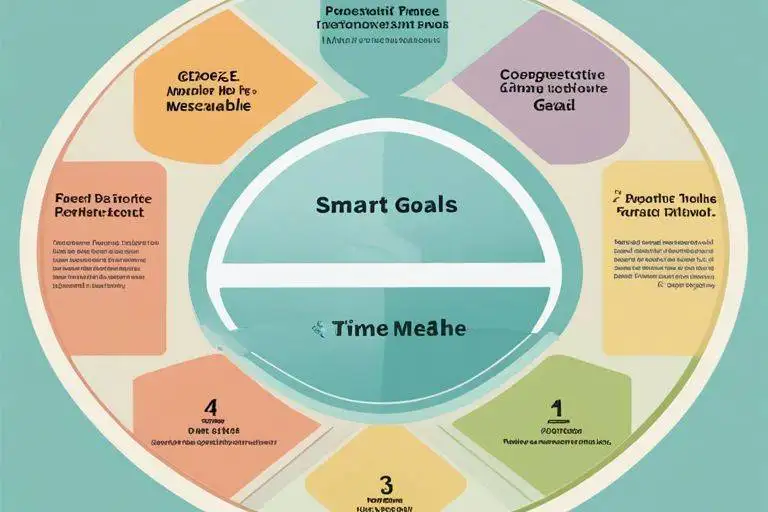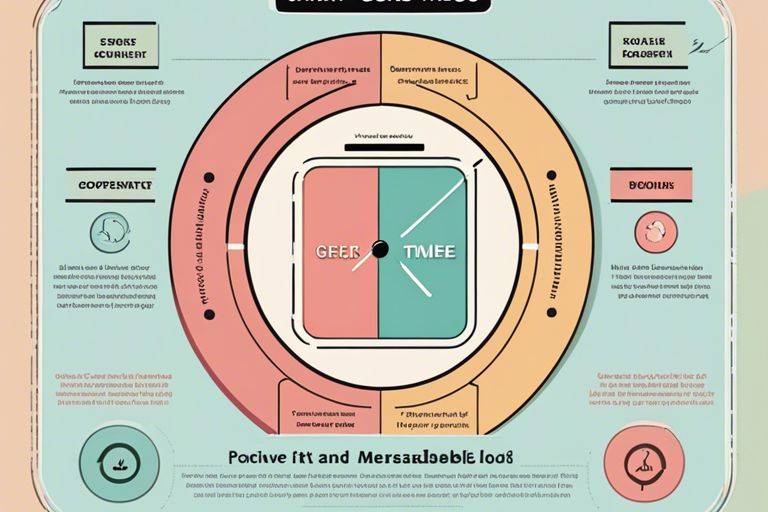SMART Goals! It’s imperative to set clear and achievable goals to ensure success in any endeavor. One method that has stood the test of time for effective goal setting is George T. Doran’s SMART method. This approach emphasizes the importance of creating goals that are Specific, Measurable, Achievable, Relevant, and Time-bound.
By following the SMART criteria, individuals and organizations can establish goals that are well-defined, quantifiable, realistic, and timely. This method not only provides clarity on what needs to be accomplished but also increases the likelihood of reaching those goals successfully. Understanding and implementing the SMART approach can lead to greater focus, motivation, and productivity in pursuit of both short-term and long-term objectives.

Key Takeaways:
- Specific: Goals should be clear and well-defined to provide a clear direction.
- Measurable: Progress towards the goal should be quantifiable to track success.
- Achievable: Goals should be realistic and attainable within the given resources and constraints.
- Relevant: Goals should align with larger objectives and be meaningful to the individual or organization.
- Time-bound: Goals should have a deadline or timeframe for completion to create a sense of urgency and focus.
- SMART framework helps in setting effective goals that increase motivation, productivity, and success.
- Regular review and adjustment of SMART goals is necessary to ensure continued progress and relevance.

The Genesis of SMART Goals
If you’ve ever set a goal or worked towards achieving a certain target, you may have come across the concept of SMART goals. This widely-used method for goal setting has its origins rooted in the work of George T. Doran, who introduced the idea in the early 1980s. Understanding the backstory of SMART goals and their creator can provide valuable insights into how this approach can help individuals and organizations achieve success.
Who is George T. Doran?
To examine into the genesis of SMART goals, it’s imperative to know the man behind the concept – George T. Doran. He was a consultant and former Director of Corporate Planning for Washington Water Power Company. Doran’s expertise in strategic planning and management led him to develop a simple yet effective framework for setting clear and achievable goals, which later became known as SMART goals.
The Original SMART Goals Model
Genesis, In his seminal article titled “There’s a S.M.A.R.T. Way to Write Management’s Goals and Objectives,” published in the November 1981 issue of Management Review, Doran outlined the original SMART goals model. This model emphasized the importance of setting goals that are Specific, Measurable, Achievable, Relevant, and Time-bound. By incorporating these criteria into goal setting, individuals and organizations could enhance their focus, motivation, and productivity.

Understanding SMART Criteria
Your goals need to be specific to provide clear direction and focus. By defining the specifics of what you want to achieve, you can avoid ambiguity and ensure a precise target to aim for. For example, a general goal like “increase sales” can be refined to a specific goal like “increase online sales by 20% in the next quarter.” This specificity helps in understanding exactly what needs to be done to accomplish the goal.
Measurable
Strategies: It is crucial for your goals to be measurable so that progress can be tracked and success can be evaluated. Establishing concrete criteria for measuring progress helps in staying on track and making necessary adjustments along the way. For instance, setting a measurable goal such as “publish two blog posts per week” allows you to track your output and determine if you are meeting the target.
Measurable goals enable you to quantify your achievements, providing a clear indication of progress. By measuring your success, you can celebrate milestones and identify areas that may need improvement, enhancing your overall goal-setting process.
Achievable
Setting realistic goals that are achievable is vital for maintaining motivation and momentum. It’s important to consider the resources, skills, and timeframe required to accomplish the goal. By setting achievable goals that stretch your abilities but are within reach, you can boost confidence and progress steadily towards success.
Understanding the level of challenge involved in achieving a goal is crucial for effective goal setting. It’s important to strike a balance between setting goals that are too easy (leading to complacency) and goals that are too difficult (resulting in discouragement). Choosing achievable goals that push you to grow while ensuring a realistic path to success is key.
Relevant
Specific goals must be relevant to your overall objectives and aspirations. Aligning your goals with your long-term vision ensures that your efforts are focused on activities that will bring you closer to your desired outcomes. When setting relevant goals, consider how they contribute to your personal or professional growth and how they fit into the bigger picture of your aspirations.
Criteria: Ensuring that your goals are relevant helps in maintaining motivation and staying committed to the goal-setting process. When your goals are aligned with your values and aspirations, you are more likely to stay engaged and dedicated to achieving them, leading to greater success in the long run.
Time-Bound
Techniques: Setting a timeframe for your goals creates a sense of urgency and helps in prioritizing tasks. By establishing deadlines for achieving specific milestones, you can avoid procrastination and stay focused on making steady progress. Time-bound goals create a sense of accountability and drive, pushing you to work consistently towards your objectives.
Practicality: The time-bound aspect of goal setting is crucial for ensuring that goals are achieved in a timely manner. By breaking down your goals into smaller, time-bound tasks, you can effectively manage your time and track your progress. Adhering to deadlines helps in maintaining momentum and achieving consistent results, leading to successful goal completion.
Applying SMART Goals in Various Contexts
Despite its simplicity, the SMART goal-setting method can be applied to a wide range of contexts to help individuals and organizations achieve success. By breaking down goals into Specific, Measurable, Achievable, Relevant, and Time-bound objectives, progress becomes measurable and attainable in different areas of personal and professional life.
Personal Development
SMART Goals in personal development can empower individuals to make positive changes in their lives. By setting Specific goals such as learning a new skill, Measurable goals like exercising for a certain number of hours each week, Achievable goals such as reading a book every month, Relevant goals that align with personal values, and Time-bound goals for better time management, individuals can track their progress and stay motivated to grow personally and achieve their aspirations.
Professional Growth
The SMART approach to professional growth involves setting clear and actionable goals that can lead to advancement in one’s career. By defining Specific objectives related to job performance, Measurable targets like increasing sales revenue by a certain percentage, Achievable goals such as completing a professional certification, Relevant goals that contribute to professional development, and Time-bound goals for career progression, individuals can map out a path to success in the workplace.
Various Business and Management
Various industries benefit from applying SMART goals in business and management. Specific objectives like launching a new product line, Measurable targets such as increasing customer satisfaction ratings, Achievable goals like reducing operational costs by a certain percentage, Relevant goals that align with business objectives, and Time-bound goals for project completion help organizations drive growth and achieve strategic milestones.
Personal accountability and effective goal-setting are key components in the business and management sector. By aligning individual and team goals with overarching business objectives, organizations can foster a culture of productivity, innovation, and performance excellence.
Professional Education and Learning
The application of SMART goals in education and learning is instrumental in guiding students, educators, and professionals towards academic and career success. By setting Specific learning outcomes, Measurable academic targets, Achievable study milestones, Relevant career-oriented goals, and Time-bound projects and assignments, individuals can enhance their knowledge and skills effectively.
This method provides a structured framework for continuous improvement and growth, ensuring that individuals have a roadmap to follow and the motivation to pursue their educational and professional aspirations confidently.
Common Pitfalls and How to Avoid Them
Overly Ambitious Goals
After setting your SMART goals, one common pitfall to avoid is the trap of overly ambitious goals. While it’s great to aim high, goals that are too ambitious can set you up for failure. Overly ambitious goals can be demotivating and overwhelming, leading to burnout and discouragement. When setting goals, it’s vital to strike a balance between pushing yourself and setting realistic expectations.
Vague and Unclear Objectives
Any goals that lack clarity and specificity are likely to result in confusion and frustration. Vague and unclear objectives make it difficult to track progress and can leave you feeling directionless. To avoid this pitfall, ensure that your goals are specific, measurable, and well-defined. Take the time to break down your objectives into actionable steps to make them more achievable.
Another way to address vague and unclear objectives is to incorporate regular checkpoints and reviews into your goal-setting process. Regularly assessing your progress can help you stay on track and make necessary adjustments to ensure you are moving in the right direction.
Ignoring the Relevance Factor
Goals that are not relevant to your overall objectives can lead to wasted time and effort. Ignoring the relevance factor means setting goals that do not contribute meaningfully to your long-term vision or mission. Before setting any goal, evaluate its significance and alignment with your larger aspirations to ensure that your efforts are focused and impactful.
Lack of Time Management
Pitfalls can also arise from a lack of effective time management when striving to achieve your SMART goals. Time management is crucial for successfully implementing your goals and maximizing productivity. Without proper allocation of time and resources, even the most well-defined goals can fall short. Consider utilizing time-tracking tools and techniques to help prioritize tasks and manage your schedule effectively.
Common pitfalls such as these can hinder your progress towards achieving your goals. Understanding these potential roadblocks and taking proactive steps to avoid them can significantly increase your chances of success.

Beyond SMART Goals: Extending the Framework
SMARTER Goals – Adding Evaluating and Review
To truly enhance the effectiveness of goal-setting, it is important to consider adding an extra step to the SMART framework. This leads us to SMARTER goals, where the ‘E’ stands for ‘Evaluate’ and ‘R’ for ‘Review’. By incorporating evaluation and review into the goal-setting process, individuals and organizations can ensure that they are continuously monitoring progress and making necessary adjustments to stay on track towards achieving their objectives.
On top of setting Specific, Measurable, Achievable, Relevant, and Time-bound goals, evaluating and reviewing the progress regularly can provide valuable insights into what is working well and what needs improvement. It allows for a more dynamic and iterative approach to goal setting, where constant feedback and analysis can lead to better decision-making and ultimately, greater success.
Other Goal Setting Frameworks
Goals are at the core of driving personal and professional growth, and while SMART goals are widely accepted and utilized, there are other frameworks worth exploring. These alternative frameworks offer unique perspectives and methodologies that can complement or even enhance the goal-setting process.
Other frameworks such as OKRs (Objectives and Key Results), BHAGs (Big Hairy Audacious Goals), and WOOP (Wish, Outcome, Obstacle, Plan) provide different approaches to goal setting and can be beneficial in certain contexts. While SMART goals provide a solid foundation, being aware of and adapting other frameworks can help individuals and organizations tailor their goal-setting strategies to better suit their specific needs and objectives.
Tools and Resources to Aid SMART Goal Setting
Now let’s explore some tools and resources that can assist you in setting and achieving your SMART goals. By making use of these aids, you can enhance your goal-setting process and improve your chances of success.
Goal Setting Apps and Software
Tools such as goal-setting apps and software can provide a structured approach to setting and tracking your goals. These technological solutions often come equipped with features like progress tracking, reminder notifications, and goal visualization tools. Some popular options include Trello, Todoist, and Evernote, which allow you to break down your goals into actionable steps and monitor your progress in real-time.
Printable Worksheets and Templates
With the abundance of printable worksheets and templates available online, you can easily map out your SMART goals in a tangible format. These resources typically include sections for defining your specific, measurable, achievable, relevant, and time-bound objectives. By filling in the details of your goals on these templates, you can gain clarity and focus on what needs to be done to accomplish them. Using worksheets and templates can streamline your goal-setting process and keep you organized throughout your journey.
This structured approach can also serve as a visual reminder of your goals, helping you stay motivated and on track. Whether you prefer a daily planner layout or a goal-specific template, there are various options to choose from to suit your individual goal-setting style.
Books and Publications
Books and publications focused on goal setting can provide valuable insights and strategies to help you set and achieve your objectives. Authors like Brian Tracy, Stephen Covey, and Tony Robbins have written extensively on the topic, offering practical guidance on goal setting, productivity, and personal development. These resources can deepen your understanding of goal setting principles and inspire you to take action towards your aspirations.
By delving into these books, you can learn from the experiences of successful individuals and gain new perspectives on how to approach your own goals. Whether you prefer audiobooks, e-books, or physical copies, incorporating these resources into your goal-setting journey can provide a wealth of knowledge and motivation.
Conclusion
Upon reflecting on George T. Doran’s method for setting clear and achievable goals, known as SMART goals, it is evident that this framework has stood the test of time in goal setting. By emphasizing specific, measurable, achievable, relevant, and time-bound objectives, individuals and organizations can effectively drive performance and track progress. Understanding the history of SMART goals, as explained in A Brief History of SMART Goals, provides valuable insights into its widespread adoption and success.
By following the SMART goals methodology, individuals and teams can bring clarity, focus, and structure to their goals. This enables them to enhance productivity, motivate action, and ultimately achieve success. As a timeless and versatile tool, SMART goals continue to be a cornerstone of effective goal setting, guiding individuals and organizations towards their desired outcomes with precision and purpose.
FAQ
Q: What are SMART Goals?
A: SMART goals are a framework for setting clear and achievable objectives. The acronym SMART stands for Specific, Measurable, Achievable, Relevant, and Time-bound.
Q: Why are SMART Goals important?
A: SMART goals provide a structured approach to goal-setting, increasing the likelihood of success by making objectives clear, measurable, and attainable.
Q: What does Specific mean in SMART Goals?
A: Specific in SMART goals refers to clearly defining the objective, answering the questions of who, what, when, where, and why to provide a precise target to aim for.
Q: How can goals be Measurable in the SMART framework?
A: Measurable goals include quantifiable criteria that allow progress to be tracked and evaluated. This provides a clear indicator of whether the objective has been met.
Q: What does Achievable signify in SMART Goals?
A: Achievable in SMART goals means setting realistic and attainable targets that consider available resources and capabilities to increase the likelihood of success.
Q: Why is Relevance important in SMART Goals?
A: Relevance ensures that the goal is meaningful and aligns with broader objectives. It helps individuals stay motivated and focused on goals that matter.
Q: How does Time-bound factor into SMART Goals?
A: Time-bound goals have a specific deadline or timeframe for completion. This creates a sense of urgency and helps individuals prioritize tasks to achieve the objective on time.



